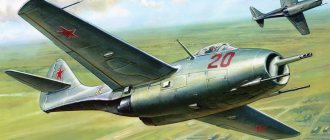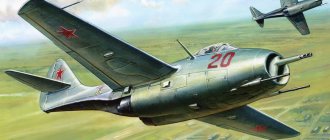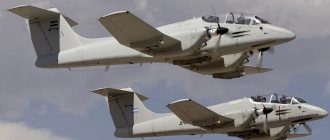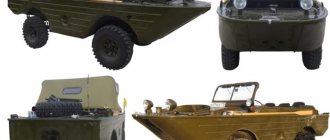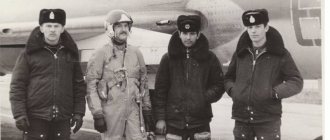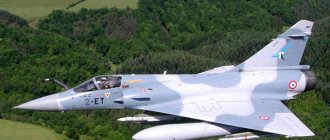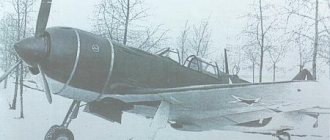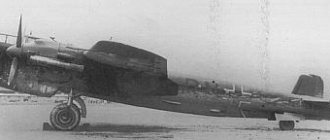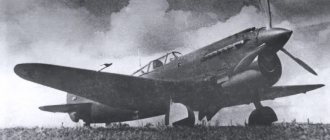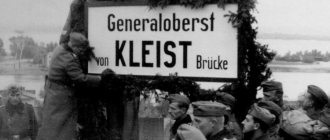MiG-17 fighter in flight. The aerodynamic ridges on the wing are clearly visible. In the post-war years, aviation developed at an unusually fast pace. The speed and carrying capacity of new jet aircraft were constantly increasing. Because of this, many fighter models created in the 40s were outdated by the second half of the 50s. The same fate could well have befallen the MiG 17, the development of which began in 1948, however, this aircraft showed amazing survivability. It has been used in many regional conflicts, and there are still countries where it is still used for its intended purpose. Of course, it is difficult for this machine to “compete” in the air with such opponents as the F-16 or F-15, but in the role of an attack aircraft it can still be of considerable benefit today.
History of the development of the MiG-17 fighter
Despite the fact that Soviet aircraft designers in the post-war years were firmly convinced that a swept wing was the best for jet aviation, they did not have a common point of view as to what exact angle of inclination would be optimal. At the stage of creating the MiG-15 fighter, various options were developed and tested. Ultimately, the designers set the leading edge sweep angle for this aircraft to 37 degrees.
Meanwhile, in December 1948, that is, even before the MiG-15 was put into service, during the flight of the experimental fighter “176” the pilot managed to reach a speed of 1.02 Mach. The wings of this aircraft, created in the design bureau of S.A. Lavochkin, had a sweep of 45 degrees, which made it possible to “overtake the sound.”
Mig-17 (in the foreground) and MiG-15. There is a noticeable difference in both sweep and wing shape
The design bureau of Mikoyan and Gurevich was well aware of the results obtained by the “competing company.” It was decided to create a version of the MiG-15 with an increased sweep wing. Initially, this aircraft was called SI-1; the designation Mig-15bis “Strela 45” was also used.
It was distinguished from the basic production fighter not only by the modified wing shape, but also by other significant details:
- Several aerodynamic ridges are installed. One of them is under the fuselage, three more are on the wings, more precisely, on the upper surface of the consoles;
- The length of the aircraft has increased. The difference compared to the MiG-15 was 0.9 m, the elongation was localized in the tail section;
- The keel has increased in size;
- The horizontal tail is given the same sweep angle as the leading edge of the new wing, that is, 45 degrees.
Tests of the experimental aircraft, which began in January 1950, showed that in a number of characteristics it was superior to the production models of the MiG-15bis. In particular, SI-1 could accelerate to a speed of 1.08M. In addition, the rate of climb has increased significantly, and at high altitudes maneuverability has also noticeably improved. The fighter proved to be stable and safe to pilot.
After the completion of state tests, the aircraft was given the designation MiG-17, and the Ministry of Aviation Industry issued an order to launch its serial production. These fighters were built in Komsomolsk-on-Amur, Gorky (now Nizhny Novgorod), Kuibyshev (Samara), Tbilisi and Novosibirsk.
In terms of mass production, only its “big brother”, the MiG-15, could compete with the MiG-17
At the same time, the aircraft was constantly improved, additional changes were made to its design. In addition, the composition of on-board equipment also changed.
Thus, in 1952, the Izumrud radar station was installed on the MiG-17, which made it possible to turn the front-line fighter into an all-weather interceptor. In 1956, the aircraft was equipped with four air-to-air guided missiles. The cannon armament had to be removed.
In the mid-50s, the Soviet leadership decided to transfer the license for the production of the MiG-17 to China, and then to two more socialist countries - Czechoslovakia and Poland. In China, this aircraft was built under the designation J-5, or F-5 (export version). As a result, the total number of MiG-17s exceeded 11 thousand copies.
Tandem of Mikoyan and Gurevich
Russian history knows several design tandems, the most famous of which is rightfully considered to be the collaboration of aircraft builders Artem Ivanovich Mikoyan and Mikhail Iosifovich Gurevich. They successfully complemented each other, but, despite their seniority and brilliant education, Gurevich always remained in the shadow of his colleague.
The designers met at the Design Bureau of Nikolai Polikarpov, the “father” of the first Soviet fighters. The combat operations of the 1930s in the Far East and Spain showed that the Soviet fighters I-15, I-16 and the new I-153 Chaika were inferior in performance to the German Messerschmitt Bf 109E. The Red Army Air Force needed a modern fighter that could reach speeds of over 600 km/h, have a high service ceiling and modern weapons.
Aircraft designers Mikhail Iosifovich Gurevich and Artem Ivanovich Mikoyan with a model of the MiG-3 fighter
The Second World War, which began in 1939, and the armed conflict between the USSR and Finland exacerbated the need for immediate renewal of the aircraft fleet of the Red Army Air Force.
Already in November 1939, at the country's largest aircraft manufacturing enterprise - Aviation Plant No. 1, a new aircraft project was selected - it was the I-200 high-speed fighter from the Polikarpov Design Bureau. A special design department was formed specifically for its creation. Mikoyan became the head of the new OKO, and Gurevich became his deputy.
In a fantastically short time - in 132 days - the I-200 fighter was created, later named after the MiG-1 designers.
The development of the MiG-1 was its improved modification MiG-3 with an increased flight range. The plane could reach a speed of 640 km/h, which was a record at that time for production aircraft.
During the Great Patriotic War, 27 pilots who fought on the MiG-3 were awarded the title of Hero of the Soviet Union. A special role belongs to the MiG-3 fighters, which defended the skies of Moscow and Leningrad during the war as part of air defense aviation, since fighter aircraft were the main means of combating enemy air. It was on the MiG-3 that ace pilot Alexander Pokryshkin began his victorious journey.
MiG-3 fighter
For the successful completion of the government's task, the staff of plant No. 1 and OKO received high government awards, and Mikoyan and Gurevich became laureates of the Stalin Prize of the first degree.
In the spring of 1942, Mikoyan's OKO returned from Kuibyshev, where aircraft factory No. 1 was evacuated in 1941. A new enterprise appears - pilot plant No. 155 (OKB-155), of which Artem Ivanovich is appointed director and chief designer. During the war years, the team of Mikoyan and Gurevich created several prototypes of aircraft, but they did not go into mass production. However, these works helped the OKB maintain its potential so that after the war it could begin developing jet aircraft, which propelled the Mikoyan OKB into the world leaders in aircraft manufacturing.
Design Features
According to its aerodynamic design, the MiG-17 is an all-metal mid-wing with one fin and a high-mounted horizontal tail. The wing sweep is differentiated: along the leading edge it is 45 degrees, and at the tips - 42 degrees.
The MiG-17 fuselage can be disassembled into nose and tail sections, which simplifies the technological operations required to replace the engine. The left aileron is equipped with a trimmer to facilitate control of the fighter when entering a roll. The cabin is made hermetically sealed and can be entered through a sliding canopy. In order to look back, the pilot can use a periscope.
MiG-17 fighter cockpit
If an emergency occurs, you can leave the plane using an ejection seat. Over time, it was equipped with a protective curtain, which increased the range of speeds at which a successful ejection was possible.
There are two internal fuel tanks, they are located in the rear fuselage. The aircraft can also use overhead drop tanks for fuel, which slightly increases the combat radius.
The MiG-17 is equipped with hydraulics for extending the landing gear, and there is a pneumatic backup system that can be used in case of emergency situations. The front wheel is retracted into a niche in the nose of the aircraft, and the main struts are retracted into the wing compartments.
MiG-27 wing
The aircraft wing consists of two fixed parts, which were fixed to the fuselage, and two rotating trapezoidal consoles. The sweep angle of the consoles is set in three positions: 16°, 45° and 72°. The central compartment is occupied by the main power element of the fixed part. It was welded to frames No. 18 and No. 20. The compartment contains units responsible for rotating the consoles and wing fuel tanks.
The rotating part of the wing consists of two spars. The rotation of the consoles is ensured by a hydraulic motor included in the SPK-1 system.
The spars are made of aluminum alloy using hot stamping technology. The wing compartments are sealed. On top of the wing there is a two-section spoiler.
The flap is three-section: the first (nose) section is made of titanium alloy, the next two are made of aluminum alloy. The flap control uses the mechanisms of hydraulic cylinders of the general hydraulic system. Each section is controlled by a separate hydraulic cylinder.
The gaps between the fuselage and the extended consoles, as well as the gaps between the retracted consoles and the fuselage, are covered by movable and fixed flaps, which strengthen the structure and provide the required seal during heavy loads on the wing.
The horizontal tail is centrally rotating and includes a front stringer, a spar, a set of ribs and skin. The central part is represented by milled panels, the bow and tail are riveted. The stabilizer is made up of two halves, each of which rotates on two bearings. A combined root bearing is installed in the side rib, and a roller end bearing is installed inside the stabilizer.
Armament of the MiG-17
Initially, the fighter was equipped with one 37-mm N-37D cannon and two 23-mm NR-23 cannons. In other words, its weapons were exactly the same as those of the MiG-15. Subsequently, the N-37D cannon on the MiG-17P interceptor was dismantled, and a third HP-23 was installed in its place.
In the PF modification, the aircraft could have either two or three HP-23s. In addition, some MiG-17F fighters were equipped with two 30-mm HP-30 cannons.
Unguided S-21 missiles, as well as 50- and 100-kilogram aerial bombs, could be used to destroy ground targets.
The most unusual weapon was the MiG-17PFU interceptor, which had no guns at all. Instead, the aircraft was equipped with four RS-2US air-to-air guided missiles and an Izumrud radar station.
Modern model of the MiG-17PFU interceptor with four RS-2US missiles
Photos walkaround MiG-17F
Photo walkaround review of the MiG-17F aircraft was taken on September 5, 2017 at the Luftwaffe Aviation Museum Berlin-Gatow.
1
Performance characteristics
Different modifications of the fighter were somewhat different from each other in terms of basic performance characteristics. As an example, we can use two fairly common aircraft options:
| MiG-17A | MiG-17F | |
| Takeoff weight | 5,340 kg (normal), 6,072 kg (maximum) | 5,340 kg (normal), 6,069 kg (maximum) |
| Aircraft weight without fuel and ammunition | 3,798 kg | 3,939 kg |
| Length | 11.09 m | 11.36 m |
| Height | 3.8 m | 3.8 m |
| Wingspan | 9.628 m | 9.6 m |
| Fuel reserve | 1,435 liters | 1,170 kg |
| Power plant power | 2,700 kgf | 3 380 kgf |
| Range of flight | 1,165 km | 1,240 km |
| Service ceiling | 14,700 m | 16,600 m |
| Maximum speed | 1,070 km/h | 1,145 km/h |
The flight range is indicated for an altitude of 10,000 meters. In addition, the fighter was capable of taking drop tanks with a capacity of 600 to 800 liters, which gave it the ability to cover a distance of up to 1,735 km. During descent and dive, the MiG-17 was allowed to accelerate to a speed of 1.15M.
sYAOEU lHts-15 ONGBNKKHK nya-155 ONKSVKhRE NR BSHYAETSN PSYNBNDYARBU YARPIUMSH YABNENAPUGMSHY YUPR-AKYUM MU DUKEMEEEE YANBEPEMYARBNBYUMKHE SCHRNI LYUHMSH. rYUY, h.b.YURYUKHM MU OPEDKNFEMKH DPSTSKHU HYARPEAHREKEMSHU nya ON MNBSHL RHOYUL YAYULNKERNB YUFDSHI PUG BNGPUYUFYUK: “with MUYA EYARE UNPNKHI lHts-15, KH MER YALSHYAKYU MY AKKHFYU IEEE BPEL YANGDUBURE MNBSHE KHYARPEAHREKH, KSVIE KHDRKH ON OSRKH LNDEPMHGYUZHHH lHtsyu...” dBHTSYUYAE B ShchRNL MUOPYUBKEMHH, YNKKEYRHB y.h.lHYNMYU H l.h.tsSPEBHVYU PUGBEPMSK PYUANRSH ON NYAMYUYEMHCH "ORMYUJURNTSN" MNBSHL YPSHKNL, VRN YASKHKN SKSVIEMKHE kru, OPEFDE BYAETSN, SBEKHVEMKHE YAYNPNYARKH. b RN BPEL B YANBERYAYNL YANCHGE MEYAYNKEIN NPTSYUMHGYUZHHI BEKH BEYAELYU ASPMSCH DEREKEMNYARE ON HGSVEMHCH YABNIYARB YPSHKYU I STSCKNL YARPEKNBKHDMNYARH 45 CPYUD. OH KHMXX 1/4 UNPD.nMN ASHKN HYAOSHRYUMN B YUSCHPNDKHMYULHVEYAYKHU RPSAYU ZHUTSH KH MU KERYUCHYKHU LNDEKU. onNDNAMSHL YPSHKNL NYAMUYARHKKH NOSHRMSHI HYARPEAHREKE "176" nya ya.yu.kYUBNVIHMYU, MU YNRNPNL 26 DAYUAP 1948 Ts. YARBSCHYEI VHYAKS l=1.02 (B ONKERE YAN YAMKHFEMHEL). MAINRNPSHI LYUREPHYUK ONKSVHKH B OPNZHEYAYAYE PUANR ON SHYAOEPHLEMRYUKEMSHL LYUHMYUL “5” YNMYARPSYZHKH l.p.aKHYAMNBURYU H MELEZHYNI RPNTEIMNI Siebel 346.
yNMYARPSYRNPYUL nya-155 OPEDYARNKN OPKHB'GYURE MNBNE YPSHKN Y YAKHKNBSHL OUYUMTSNSRYUL TCHGEKKFYU lHts-15 KH YANUPYUMHRE OPH SCHRNL ZHEMRPNBYS YYULNKERYU. b PEGSKERYURE YPSHKN ONKSVHKN DBNIMSCH YARPEKNBKHDMNYARE: NR ANPRNBNI MEPBCHPSH DN OPHLEPMN ONKSPYUGLYUYUYUYU - 45 CPYUD. , YU DUKEE - 42 CPYUD. (STSKSH YARPEKNBKHDMNYARKH ON OEPEDMEI YPNLYE YANNRBERYARBEMMN PYUBMKKHYAE 49 CPYUD. X 45 CPYUD. 30′). gYYNMZHNBYH YPSHKYU BSHONKMHKH YAYPSTSKEMMSHLH B MYUDEFDE SBEKHVHRE YUSCHPNDHMYULHVEYAYNE YUVEYARBN. mu BEPUMEI ONBEPUMNYARH YUFDNI YNMYANKH DNAYUBHKH EYE OH NDMNLS TsPEAMCH DK OPEDNRBPUYEMKH OEPEREYUMKH ONRNYU BDNKE PYUGLYUYU. nRMNYAHREKEMSCH RNKYHMS YPSHKYU SLEMEHKH X SKSVIHKH ETSN YANOPFEMKHE I TCHGEKFEL.
dK DNPUANRYKH ASHK BGUR YAYULNKER lHts-15AHYA I DBHTSUREKEL b-1. MEDYUPNL LNDEPMHGHPNBYUMMYU LYUHMYU, YPNLE THPLEMMNTSN LHTPYU yah
, HLEMNBUKYUYAE lHts-15AHYA 45 CPYUD. (HKH lHts-15AHYA "YARPEKYU 45"), oEPEDMCHCH VYUYARE TCHGEKKFYU NYARYUBHKH AEG HGLEMEMKHI, GYUDMCHCH SDKHMHKH MU 900 LL, BBEKH RNPLNGMSHE YHRYH SBEKHVEMMNI OKNYYUDH (1.76 L2), YHKE RUYFE MELMNTSN SBEKHVHKH. TsNPKHGNMRYUKEMNE NOEPEMKHE BSHONKMKHKH GUMNBN I STSCKNL YARPEKNBKHDMNYARKH ON OEPEDMEI YPNLYE 45 CPYUD. (With lHts-15 - 40 CPYUD.). dK SBEKKHVEMH OSREBNY SYARNIVKHBNYARKH ASHK SYARYUMNBKEM ONDTCHGEKFMSHI TSPEAME. b YAKHYARELS SOPYUBKEMKH BBEKKH TSKHDPNSYAKHKHREKE SHKEPNMNB, YNRNPSHI SYARYUMNBKKH GYU YAHDEMEEL KERVKHYU. ONGDMEE DK YAMHFEMKH SYAKHKHI MU PSVYE TNPLS MNYAINB PSKEY BSHYANRSH HGLEMHKKH MU ONKSYPSTSKSCH BLEYARN SCHKKHORKHVEYAYNI. NAYKHI BMSRPEMKHI NAZEL RNOCKHBYU SLEMEHKYA DN 1412 K. bNNPSFEMKHE yah ASHKN YUMYUKNTSKHVMN BNNPSFEMCHCH lHts-15AHYA: NDMYU OSYU m-37 X DBE mp-23.
NYAMNBMSHE NRKHVHYAH NR KHYARPEAHREK LKhts-15AHYA:
- YPSHKN I STSKNL YARPEKNBKHDMNYARH 45 CPYUD. OH KHMXX 1/4 UNPD;
- STsNK ONOEPEVMNTSN V SBEKHVEM DN -3 CPYUD.;
- MU BEPUMEI ONBEPUMNYARKH YNMYANKEY YPSHKYU SYARYUMNBKEMN ON RPH YUSCHPNDKHMYULKHVEYAYKHU TsPEAM;
- UBNYARNBYUYARE TCHGEKFYU SDKHMEMYU MU 900 LL;
- TsNPKHGNMRYUKEMNE NOEPEMKHE I STSKNL YARPEKNBKHDMNYARKH 45 CPYUD;
- SBEKKHVEMYU OKNYYUDE BEPRKHYUKEMNTSN NOPEPEMKHYA 4 L2 DN 4.26 L2;
- SYARYUMNBKEM ONDTCHGEKFMSHI TSPEAME.
b KhChKE 1949 Ts .
), NDMUYN ETSN DNBNDYU OPNDNKFYUKYUYAE EYE MEYAYNKEIN LEYAZHEB, X MU YUSCHPNDPNL khkh B fSYNBYAYNL DK OPNBEDEMKH GYUBNDYAYKHU HYAOSHRYUMKHI LYUHMS OPEDYUKH KHIE B YNMZHE TSNDYU. KERVKHYNL-HYAOSHRYUREKEL ASHK MYUGMYUVEM TCEPN YANBERYAYNTSN YANCHGYU h.r.khBYUYEMYN, OEPEEDKHI B NYA-155 B 1945 Ts. NBERYAIKHU OKKNRNB, SDNYARNEMMSHU ETSN GYU NYABNEMKHE PEYURKHBMNI REUMKHYKH. xBYUYEMIN YUYRKHBMN SVYUYARBNBUK B PUANRYU ON DNBNDYE YAKHYARELSH YUBYUPKHIMNTSN ONYKHDYUMKH lHts-15, RYU VRN yah ONOYUK B PSYKH NOSHRMNTSN KERVKHYU, GMYUYNLNTSN YAN LMNTsHLH YAC POPHGYULH OEPBSH PEYURKHBMSHU LYUHM.
oEPBSHI ONKER NOSHRMNI LYUKHMSH YANYARNKYA 14 ЪМБУПЪ 1950 Ts. SFE B MUVYUKE GYUBNDYAYHU HYAOSHRYUMKHI ASHKN SYARYUMNBKEMN, VRN LYUYAHLYUKEMYYAYNPNYARE YAH OPEBSH YUER RUINBSCH lHts-15AHYA OPHLEPMN MU 40 YL/V. LYuYYAHLYUKEMNE YUSCHPNDHMYULHVEYAYNE YUVEYARBN YAMKHGHKNYAE I 13.9 DN 13.6, VRN OPHBEKN Y SLEMEYEMKHCH DUKEMNYARKH ONKERYU OPH NDKHMYINBNI I lHts-15AHYA GYUOPYUBYE RNOXBNL M Yu 35 YL. b OPNZHEYAYAYE HYAOSHRYUMKHI ASHKYU OPNDECYUM ANKEYU PUANRYU ON DNBNDYE LYUKHMSH (B VYYARMNYARKH, SKSVIHKH ITS TSEPLERKHVMNYARE), VRN DUKN MEANKENNI DNONKMHREKEMSHI OPKHPNYAR YAYNPN YARH.
1 TEBPYUK B NVEPEDMNL ONKERE xBYUYEMYN MU BSHIANRE 2200 L PUGNTSMYUK YAYULNKER DN 1114 YL/V. BYAYNPE MU BSHIANRE 10200 L SDYUKNYAE ONKSVHRE LYUYAKHLYUKEMSC YAYNPNYARE 1077 YL/V, VRN YANNRBERYARBNBUKN VHYAKS l=1.0. bSHЪBHKHYAE X DPSTSKHE OPEHLSYYARBU LNDKHTHZHHPNBUMMNTSN KHYARPEAHREK OEPED lHts-15AHYA HE NYAMNBMSHL cru. mN OPNBEYARKH GULEP BYAEU UYUPYUREPHYARKHY yah, B R.V. BGKERMN-ONYADNVMSHU, ME SYAOEKH. 17 LYUPRYU xBYUYEMIN NROPYUBHKYA B NVEPEDMNI ONKER. mYuAPYUB 11000 L, NM BSHONKMKHK MYULEVEMMSCH OPNTsPYULLS X, ME NAMYUPSFHB B ONBEDEMKHH LYUKHMSH MHVETSN MNBNTsN, YAMKHGHKYAJ DN 5000 L. mENFKHDUMMN YAYULNKER BNYEK B YPSRNE OKHYHP NBYUMHE. MYALNRP MU BEYAE YABNI NOSHR, KERVKHY ME YALNTS YAOPYUBHREYA I YAHRSYUZHHEI KH DUFE ME SYAOEK OPEDYURE ON PUDHN MH YAKNBU. yah BPEGYUKYA B GELKCH I NTsPNLMNI YAYNPNYARECH. oHKNR ONTSKHA, YU NR LYUKHMSH NYARYUKHYAE KKHE LEKYKHE NAKNLYKH.
vRNASH PYUGNAPIUREYA B OPHVHMYU YAKSVKHBETSNYA, RPEANBUKNYAE OPNDNKFHRE KERMSHE SHYAOEPHLEMRSH. eYE DN TsKHAEKH h.r.khBYUYEMIN, y.h.lKHYNYM OPHTSKYUYAKHK B nya BNEMMNTSN KERVKHYU-HYAOSHRYUREK ts.yu.yaEDNBYU, PYUANRYUBYETSN DN SCHRNTSN B tsy mkhx bbya. I LYUPRYU 1950 Ts. NM MYUVYUK ONKERSH MU NOSHRMNL yakh-2, ONYARPNIIS YNRNPNTsN GUYNMVHKH B MYUVYUKE TsNDYU. b NDMNL KH ONKERNB YaEDNB ONOYUK B SYAKNBKH, AKHGYKHE Y REL, YNRNPSH OPHBEKH Y TsKHAEKKH xBYUYEMYN. ONYAKE OPEBSHYEMKH YAYNPNYARKH 1000 YL/V MYUVYUKYA TKYURREP YARYUAHKHKHYURNPYU, B PEGSKERYURE VETSN PSKH BSHYANRSH B GMYUVKHREKEMNI YAREOOEMKH PYUGPSKHKHYAE - NR MHU NYARYUKNYAE NYNK N 40% WINDOW YUDH, BMEMKHE VYUYARKH ASHKKH NRNPBYUMSH YAHLLERPHVMN I NAECH YARNPNM. oHKNRS SDYUKNYAE OEPEBEYARKH HYARPEAHREKE B MUANP BSHIANRSH, YAMKHGHRE NANPNRSH DBKHTSUREK K H ONTSYUYAKHRE YAYNPNYARE. oNGDMEE ts.yu.yaEDNB BIAONLKHMYUK: « TSNRNBHKYA Y SHRNLS PEFHLS GYUPYUMEE, RYU YUY LSH GMYUKH, VRN PYUGPSIEMKHE TsNPKHGNMRYUKEMNTSN NOPEPEMKH MY OEPBNI NOSHRMNI LYUKHME OP NHGNYKN MU YAYNPNYARKH 1020-1044 YL/V. aSHYARPYU PEYUYZHKH KERVKHYU GDEYAE MH OPH VELT. yNTsDU BYAE SHRN OPNKHGNKN, YAYULNKER MUUNDHKYA B MNPLYUKEMNL ONKNFEMHKH DUFE YARYUK MELMNTSN GYUDKHPYURE ME. ONOPNANBYUK PSKKH BSHYANRSH - LYUKHMYU ONDVKHMYERYA. oPUBDU, OPH GUUNDE MU ONYYUDYS, YNTSDU SOYUKYU YAYNPNYARE, ASHKYU NOYUMNYARE, VRN OKNYYUDH NYARYUBKHYA PSKEY ME UBYURHR, MN BYAE NANKNYAE, X NOSHRMYU LYUKHMY ASHKYU IYYYYYYYYYYYYYYYYYYYYYYYYYYYYYYYYYYYYYYYYYYYYU.” yPNLE TKYURREPYU, BN BPEL GYUBNDYAIKHU HYAOSHRYUMKHI yah-2 yaEDNB NAMYUPSFHK RUINE ЪBKEMKHE, YUY PEBEPA SHKEPPNMNB. dK OPNBEDEMKH MENAUNDHLSHU DNPUANRNNY YAYULNKERYU B YNMZHE 1950 Ts. HYAOSHRYUMKH OPHKNYAE OPEPBYURE.
b YAKEDSCCHYEL TsNDS MU TSNPAINBAYNL YUBKHYUGYUBNDE N21 KHTsNRNBHKH EYE DBY OPNRNRKHOYU, NDMNBPELEMMN ЪBКББХУЯЪ ЦНКНБМШЛХ YАЭПХИМШЛХ LYUHMYULH (GYUBNDYAYNI bHTP - “X” WHERE 54").
16 TEBPYUK GYUBEPHKYUYAE YANPIYU YYULNKERYU yah-02 (BRNPNI TsNKNBMNI YAEPHIMSHI, GYUBNDYAYNI N54210002), Y ONYARPNIYU VERBEPRNI LYUKHMSH yah-01 (OEPBYU TsNKNBMYU YAEPKHIMYU, G YUBNDYAYNI N54210001) GYUBEPHKYUYAE KHIE B LYUE. BEYAMNI 1951 Ts. b YOOPEKE YAYULNKER OEPEDYUKKH B tsy mxx bbya MU tsNYASDYUPYARBEMMSHE HYAOSHRYUMKH (tskh). oEPBSHI ShchRYUO GYUBEPKHKYA 1 KhChK, y RNLS BPELEMH KERVKHYKH HMYARKHRSRYU k.l.ySBKHMNB, ch.yu.yuMRKHONB, b.ya.yNRKNB KH DPSTSKHE 75 PYUG ONDMKHLYUKH YU BNGDSU NOSHRMSCH LYU HMS. b yUYRE OH PEGSKERYURYUL SHRNTSN ShRYUOYU tskh NRLEVYUKNYAE, VRN B ZHEKNL KHYARPEAHREKE YANNRBERYARBSER OPEDZBKEMMSHL RPEANBYUMHOL. NAMYUPSFKHKHYAE H MEDNYARYURYKH, B VYUYARMNYARKH, BKKHЪMHE ONDBEYAMNTSN AYUYU MU YUYUPYUREP NAREYUMHK obd, VRN OPHBNDHKN Y HYAYUFEMKHCH ONYUGYUMKHI SYUGYUREK YAYNPNYARKH.
nRLEVEMMSHE MEDNYARYURYKH ASHKKH ASHIARPN SYARPUMEMSH, KH SFE 10 KHCHK MYUVYUKYA BRNPNI SHRYUO tskh. xYAOSHRYUREKH OPKHKH Y BSBNDS, VRN ON UYUPYUREPHYARKHYUL SARNIVKHBNYARKH SOPYUBKELNYARKH YYULNKER MEGMYUVHREKEMN NRKHVYUKYA NR lHts-15AHYA. ndMUYIN MEYAINKEIN SUSDKHKHYAE TsNPKHGNMRYUKEMYU LYUMEBPEMMNYARE. YaMKHGKHKHYAE X BGKERMN-ONYUDNVMSHE UYUPYUREPHYARKHYKH, MN ShRNLS ME OPKHDYUKH NYANANTSN GMYUVEMH, R. J. KHYARPEAHREKE LNTs ShYYAOXYURKHPNBUREYA I REU FE YUSCHPNDPNLNB, VRN X lHts-15. BRNPNNI SHRYUO TSNYAHYAOSHRUMKHI GYYNMVHKYAJ 8 YUBTSSYARYU. b GYUYKCHVHREKEMNL yYRE YNLHYAYAH GYOOHYUKYU: “lNDHTHTHZHHPNBUMMSHY YYULNKER lHts-15AHYA YAN YARPEKNBHDMNYARECH YPSHKYU 45 CPYUD. X MNBSHL UBNYARNBSHL NOPEPEMHEL HLEER OPEHLSYYARBU OEPED YEPPHIMSHL lHts-15.
- sBEKHVHKHYAE LYYYAHLYUKEMSHE YAYNPNYARKH MU 46-56 YL/V.
- ONBSHIAHKNYAE VHYAKN l DN 1.08 BLEYARN 0.92.
- sBEKHVHKYUYAE LYUMEBPEMMNYARE MU ANKENI BSHIANRE.
- sLEMEHKNYAE BPEL MUANPU BSHYANRSH 10000 L MU 20-30 YAYSMD.”
tPNMRNBNI HYARPEAHREKE ASHK PAINLEMDNBYUM B YAEPKHCH DK OPKHMIRKH MY BNNPSFEMKHE. YaYULNKER ONKSVHK NANGMYUVEMKHE lHts-17
. GYUBNDYAYKHE HYAOSHRYUMKH NOSHRMNTSN yakh-01 MYUVYUKHYAE 1 KHCHM KH GUYNMVHKHYAE 23 VHYAKYU RNCN FE LEYAZHYU. b YUBTSSYARE YaEDNB OPNBEK HYAOSHRYUMKH SCHRNTSN YAYULNKERYU MY URNONP, YU I 11 YaEMRAP ON 10 NYRЪAP YUMYUKNTSKHVMSHE ONKERSH B mxx bbya BSHONKMHK ySBKHMNB. b PEGSKERYURE ASHK YADEKYUM BSHBND, VRN “┘BSHONKMEMHE LRNONPYU KH BSHBND KH METSN MU lHts-17 AEGNOYUYAMEE H OPNYE, VELE MY LHts-15.” KERVKHYKH NRLEVYUKH, VRN YAYULNKER LNTs OPEUNDHRE B OEPEBEPMSRSHI LRNONP HKKH OEPEBEPMSRSCH YAOKHPYUKE RNKEIN OPH TsPSASHU NHAYUU B REUMKHYE OKHKNRKHPNBYUMKH.
oPKHYUGNL luo N851 NR 1 YAEMRP 1951 Ts. OPEDOKHYASHBYUKNYAE MUVYURE OPNHGBNDYARBN lHts-17 MU ORRKH GYUBNDYUU: B ySIASHYEBE, RAKHKHYAKH, TsNPAINL, mNBNYAHAKHPAYE X YNLANLNKEYAYE MU YULSPE. b UNDE OPNHGBNDYARBU YNMYARPSYZHK HYARPEAHREK DNPUAYURSHBUKYUYAE. RYUY, YAEPKHIMSHE lHts-17 ONKSVHKH BNGLNFMNYARE MEYARKH MU GYULYUU d4-50 BLEYARN ora DBE ANLASH ON 50 HKH 100 YTS. kYULOS-TYUPS BSHMEYAKH KH BNGDSUNGYUANPMHYU OND YPSHKN. rNOKKHBMSCH YAHYARELS SKSVIHKH GYU YAVER TSEPLERKHYUZHHH OPEDNUPYUMHREKEMSHU YKYUOYUMNB B LYUTSKHYARPYUKH MYUDDSBU ONDBEYAMSHU AYUNB. b 1952 Ts.nya-155 OPNBEKN HYAYAKEDNBYUMHЪ ON NOPEDEKEMHCH NORHLYUKEMSHU TNPLSH X WINDOWS RNPLNGMSHU YKHRYNB. mu DBSU lHts-17 ASHKH HYAOSHRYUMSH B ONKERYUU OJRE BYUPKHYUMRNB SHCHRKHU SYARPNIYARB. b PEGSKERYURE YKHRYKH WINDOWS ON 0.88 L2 ONKSVHKH SDNBKERBNPHREKEMSCH NZHEMYS KH I YAEMRAP MUVYUKH OKHLEMREYA MU YARPNYKHUYA KHYARPEAHREKU. I YNMJYU 1953 Ts. YULNKERYU. aSHK HGLEMEM OEPEOKER YADBKHFMNI VYUYARKH TNMYUP, VRN GMYUVKHREKEMN SKSVIKHKN NAGNP GYUDMEI ONKSYATEPSH. ONGDMEE MU YAEPHIMSHU YYULNKERYUU ONEBHKHYAE OEPKHYAINOSH. aShK PYYYAHPEM X NAMNBKEM YANYARYUB NANPSDNBYUMKH, B VYUYARMNYARKH, YARYUKH HYAONKEGNBURE OPKHZHEK yuyao-3m, DNAYUBHKH YAKHYARELS OPEDSOPEFDEMHЪ ON NAKSVEMXX pkya "YAHPEMYU-2", OEPBNM YUVYUKEMN KHLEMNBYUBYUSCHYA "OPHANPNL GYUYKHRSH UBNYARYU". KHYARPEAHREKE ONKSVKHK LNDEPMKHGKHPNBYUMMSHI by-1yu, YNRNPSHI NAKYUDYUK GMYUVKHREKEMN ANKEHL PEYASPIANL. YaYULNKERSH I SHCHRHL DBHTSUREKEL H MEGMYUVHREKEMSHLH HGLEMEMHYLH B NANPSDNBYUMHH NANGMYUVYUKHYAE lHts-17yu.
REUMHVEYAYNE NOHYUMHE
KHYARPEAHREKE lHts-17 OPEDYARYUBKYER YANANI YKYUYAYAHVEYAYKHI YAPEDMEOKYUM. yPSHKN - ZHEKEMNLERYUKKKHVEYAYNE DBSUKNMFEPNMMNE, I BMSRPPEMMHL ONDINYANL; YANYARNHR XG ZEMRPNOKYUMYU X DBSU YNMYANKEY. sTsNK YARPEKNBKHDMNYARKH YPSHKYU ON OPEDMEI YPNLYE B YNPMEBNI VYUYARKH - 45 CPYUD., MU YNMZHYUU - 42 CPYUD.
schKEPNMSH OKNYYUDECH 1.6 L2 I STSKYULH NRYKNMEMKH B DHYUOYUGNME -18 CPYUD.- +18 CPYUD. DN NYAH BPYUYEMH HLECHR BMSRPEMMCHCH YUSCHPNDHMYULHVEYAYSCH YNLOEMYUZHCH. mu KEBNL SCHKEPNME SYARYUMYUBKHBUKYA RPHLLEP.
yHRYH-GUYPSHKYH YAN YAYNKEGYYEI NYAECH BPYUYEMH OKNYYUDECH 2.86 L2 NRYKNMYCHRYA MU BGKERE MU STsNK 20 CPYUD. X MU ONYAUDYE MU 60 CPYUD. sDKKHMEMKHE YPSHKYU - 4.08, YASFEMKHE AEG SVERYU OEPEDMETSN MYUOKSHBYU - 1.23, STsNK SYARYUMNBYKH - +1 CPYUD.
tCHGEKЪF YAYULNKERYU - ONKSLNMNNYYYA LYUYAKHLYUKEMSHL DHYULERPNL 1.45 L X DKHMNI 8.805 L. nM YANYARNHR XG MNYANBNI X UBNYARNBNI VYUYAREI, HLECHYKHU REUMNKNTSKHVEYAYKHI X SCHYAOXYU RYUZHNMMSHY PYUGZEL ON ІОУМЦНРС No. 13. RYUYU YNMYARPSYZHKH NAEYAOEVKHBUER SDNAMSHY LNMRYUF KH DELNMRYUF DBKHTSUREK.
b OEPEDMEI VYUARKH TCHGEKFYU MUUNDHRYA TSEPLERHVEYAYU BEMRKHKJHNMMNTSN RHOYU YUAHMY KERVHYU. TNMYUPE, YANYARNYYKHI HG YNGSHPEYU X YADBHTSYUCHYEYYYUGYUD YAYEZHHH, NYAMYUYEM FKhDYNYARMSHL YUMRKHNAKEDEMHREKEL. dK SKSVYEMKH NAGNPYU GYUDMEI ONKSYATEPSH MU YADBHFMNI VYUYARKH KHLERYA OEPKHYAYNO.
oHKNR YAHDHR B YYURYUOSKERMNL YPEYAKE, NAEEAOEVKHBYUCHYEL ONYKHDYUMKHE YYULNKERYU OPH MYUFYURKHH PSVEY, PYYYAONKNFEMMSHU MU ONPSVMYU YAHDEME. mu ONYAKEDMKHU YAEPKHU lHts-17 SYARYUMYUBKHBYUKH YPEYAKYU I GYUYHRMNI RNPNYNI. b MNYANBNI VYUARKH TCHGEKKFYU MYUNDRYA RUYFE BUNDMNI YUMYUK BNGDSUNGYUANPMHYU (B YAYULNL MYVYUKE NM NAYKHI, MN DUKEE PUYAUNDHRYA MU DBYU, NAUND YUAHMS), KYUTER I YUPRHKK EPKHIYAYNI SYARYUMNBYNI, OPHANPMNE KH PUDHNNANPSDNBYUMKHE, MNYANBU YARNIYU YUYAYAH I MKHYEI ITS SANPYKH.
b UBNYARNBNI VYUYARKH TCHGEKFYU PUYAONKNFEMSH DBU RNOKHBMSHU AYUYU. ON ANYUL SYARYUMNBKEMSH NRYPSHBUCHYKHEYA BOEPED RNPLNGMSHE YKHRYKH I STSCKNL NRYKNMEMKH 55 CPYUD.. (MU YAYULNKERYU OEPBSHU YAEPHI - 50 CPYUD..). yHMELYURHYU LEUUMHGLYu SOPYUBKEMKH YKHRYYULH BSHONKMEMYU RYU, VRN B YAKSVIUE PUGPSYEMKH RPSANOPNBNDYU TSKHDPNYAHYARELSH NMH GUIPSHBUCHRYA OND DEYARBHEL MUONPU BNGDSUYU. OND UBNYARNBNI VYUYARECH TCHGEKKFYU MUUNDHRYA MEANKENNI TYUKEYHKE DK SBEKHVEMHYUOYUAYU OSREBNY SYARNIVKHBNYARKH.
UBNYARNBNE NOEPEMKHE YKYUYAYAHVEYAYNI YAUELSH, YARPEKNBKHDMNE. OKNYYUDE BEPRKHYUKEMNTSN NOEPEMKH - 4.26 L2, TsNPKHGNMRYUKEMNTSN - 3.1 L2. BEPRKHYUKEMNE NOEPEMKHE, MUAPYUMMNE HG OPNTKHKEY NACA-M NRMNYAHREKEMNI RNKYKHMNI 8.8% OH ONRNYS, YANYARNHR XG YHKЪ X PSK ONBNPNRYU. ONYAKEDMKHI HLEER OKNYYUDE 0.947 L2 X STSKSH NRYKNMEMKH B DHYUOYUGNME NR -25 CPYUD. DN +25 CPYUD. sTsNK YARPEKNBKHDMNYARKH BEPRKHYUKEMNTSN NOPEPEMKH ON OEPEDMEI YPNLYE - 55 CPYUD. 41′, YASPHEMKHE-2.79. TsNPKHGNMRYUKEMNE NOEPEMKHE I SDKHMEMKHEL 3.26 X YASFEMKHEL 2.0 BYKCHVUER YARYUAHKHKYURNP X PSKE BSHYANRSH OKNYYUDECH 0.884 L2, MUAPYUMMSHI XG OPNTKHKEY NACA-M I NRMNYAHREKEMNI RNKYKHMNI 8.7% OH ONRNYS. pSKE BSHYANRSH NRYKNMYERYA BBEPU MU STsNK 16 TsPYUD., Yu BMHG - MU 21 TsPYuD.
yuYAYAH - RPEUNONPMNE, I MNYANBSHL YNKEYANL. NYAMNBMSHE YNKEYAYU - RNPLNGMSHE, PUGLEPNL 660×160 LL, MNNYANBNE YNKEYAN PUGLEPNL 480×200 LL. YNKE YUYAYAKH - 3.849 L, OPNDNKEMYU AYUGYU - 3.368 L. SANPYU X BSHOSYAY YUYAYAKH OPNKHGBNDYARYA TSKhDPYUBKKHYNI, YUBYUPHIMSHI BSHOSYAY-OMEBLNYAHYARELNI. YARNЪMNVMSHI SCNK YAYULNKERYU OPH MENAFYURSHU OMEBLURHYUU 2 CPYUD.. 15′.
sOPYUBKEMKHE YYULNKERNL NYASYYARBKERYA I ONLNYECH PSK BSHYANRSH SCHKEPNMNB, YKHMELYURKHVEYAYKH YABGYUMMSHU I PSVYNI SOPYUBKEMKH, X PSKEL ONBNPNRYU, YABGYUMMSHL I OEDYUK YLH. dK YAMKHFEMKH SYAKHKHI MU PSVYE SOPYUBKEMKH B YUMYUKYU YPEMYU KH RYUMTSYUFYU SYARYUMNBKEMSH MENAPIURKHLSHE TSKHDPNSYAKHKHREKH as-1l. SOPYUBKEMKHE PSKEL BSHYANRSH DSAKHPSERYA RPNYANBNI OPNBNDYNI.
MU lHts-17 X lHts-17o SYARYUMYUBKHBUKYA rpd by-1yu I ZHEMRPNEAFMSHL YNLOPEYANNPNL, MU lHts-17t X lHts-17ot-by-1t, NRKHVYUBHIYA MYUKHVHEL TNPYUFMNI YULEPSH. pEYASPYA DBKHTSUREK B 1952 Ts. YANYARYUBKK 250 V.
LYuYAKHLYUKEMYU RBKHTSYUREK DNYARKHTSYUERYA S GELKKH OPH MSKEBNI YAYNPNYARKH. rЪTsYU PEGYN OYUDUER I BSHIANRNI H, MUOPHLEP, MU 10,000 L OPH YAYNPNYARKH ONKERYU 900-1000 YL/V PYUBMY 1500-1600 YC MU TNPYUFE X 1030-1050 YC - MU BGKERMNL PEPHLE . OPH ONYARNMMNI BSHIANRE RYTSYU DBKHTSYUREK MU BGKERMNL PEFHLE DN YAYNPNYARKH 500-700 YL/V ONMKHFUERYAJ, YU GYUREL MYUVKHMYUER OKYUBMN BNGPUYARYURE. mu PEFHLE TNPYUFYU BNGPUYARYUMKHE RTTSKH MYUVKHMYUERYYAN YAYNPNYARKH 500-600 YL/V.
dBKHTSYUREKE NUKYUFDUKYA BNGDSUNL, OPNREYUBKHL LEFDS ETSN YAREMYULH H TCHGEKFEL. mu MEINRNPSHU YYULNKERYU SYARYUMYUBKHBYUKHYAE DBKHTSYUREKH by-1t I SYAKHKEMMNI TNPYUFMNI YULEPNI, DNOSYAYYUBKHE PETSKKHPNBYUMKHE RTTSKH MU TNPYUFE OSREL DPNYAYAEKHPNBYUMKH, YAMH FUBIETSN NANPNRSH DN 10 870 NA/LHM. b YANNRBERYARBHH I DKHPEYRKHBNI bbya NR 22 ЪМБУПЪ 1959 Ts. Kommersant ONKER I 11 560 NA/LHM. oPH ONMHFEMMSHU NANPNRYU BNGPUYARYUKH MU 8% DKHMYU PYUGAETSIU KH MU 20-25% BPEL MUANPU BSHYANRSH. LYUYAKHLYUKEMYU YAYNPNYARE B GYUBHYAHLNYARKH NR BSHYANRSH ONKERYU YAMHFYUKYUYAE MU 10-30 YL/V, YU OPYURKHVEYAYKHI ONRNNKNY SLEMYUKYA MU 500 L.
rNOKKHBN MUUNDHKNYAE B TCHGEK'FE X YPSHKE. b UBNYARNBNI VYUYARKH TCHGEKKFYU LNMRKHPNBYUKKHYAE DBYU AYUYU: NDHM LITSYKHI PEGHMN-RYUMEBSHHI, DPSTSNI - DBSUYAYEZHNMMSHY LERYUKKKHVEYAYKHI. b YPSHKEU PYUGLEYUKHYAE LEYARE RNKOKHBMSHU AYYNB: DBYU ELYNYARECH ON 65 K, DBYU ON 75 K X DBYU ON 45 K. ONB ELINYARECH ON 400 K YYUFDSH - MU YARNIYUU H I NAREYUREKEL. oEPBSHI XG MHU DHYULERPNL 0.526 L X DKHMNI 3.01 L, BRNPNI-DHYULERPNL 0.52 X DKHMNI 2.81 L. nAYu RHOYU HLEKH YARYUAHKHGYURNPSH.
TsKHDPUBKHVEYAYU YAKHYARELYU lHts-17 YANYARNHR HG MYUYANYU, AYUVYU I TsKHDPUBKHVEYAYNI YALEYAYECH X BNGDSMNTSN YYYSLSKRNPYU I PYUGTSPSGNVMSHL YUBRNLYURNL.
b YANYARYUB NANPSDNBYUMKH YAYULNKERYU BUNDHKKH YABGMYU PUDHNYARYUMZHKH PYAH PYAH-3 "YKEM" (B OPNZHEAYAYE SCHYAOXYURYUZHKH GYULEMBYUJYAJ MY PYAHS-4B "DSA" KHKH p-800), YUBRNLYURKH VEYAYKHI PYUDKHNYNLOYUYU UP-5 "YULSP", NANPSDNBYUMKHE DK YAKEONI ONYYUDYKH Nyao-48, PUDHNBSHYANRNLEP LYUKSHU BSYANR pb-2 “YPHYARYUKK”, LYUPYEPMSHI PUDHNOPHELMHY lpo-48 “UPHGYUMRELYU”, SCHKEIRPHTHTHZHHPNBUMMSHE YYYAYAYERSH YAKHTSMYUKEMSHU OYURPNMNB schyaip-46 X OEPKHAYNO NAGNPYU GYUDMEI ONKSYATEPSH. mu MEINRNPSHU LYUHMYU SYARYUMYUBKHBYUKH MYUBKHTSYUZHNMMMSHI KHMDHYURNP mx-50a, OPEDMYUGMYUVEMMSHI DK NOPEDEKEMKH MUOPYUBKEMKH YAYNPNYARKH BERPU. BONYAKEDYARBHKH DNAYUBHKH YAHTSMYUKHGYURNP PUDHNKNYUZHNMMNTSN NAKSVEMKH "YAHPEMYU-2", OEPBNMYUVYUKEMN NANGMYUVYUBKHIYYYU "OPKHANP GYUYHRSH UBNYARU", NRBERVKHY YAPN-1 "AUP HI" (GYUREL "uPNL") X OPHELMKHY BNGDSMNTSN DYUBKEMKH od-gyu.
schKEIRPNNANPSDNBYUMKHE GYUOHRSHBYUKNYAE NR TSEMEPYURNPYU MU DBKHTSUREKE HKKH YYYSLSKIRNPU 12Jul-25. mu YAYULNKERE HLEKHYAE YNLOKEIR MYUBKHTSYUZHNMMSHU NTsMEI X ONYUDNVMYU TYUPYU.
mu ANKEHU BSHYANRYU HYAONKEGNBUKKHYAE YHYAKNPNDMSHI OPHANP yo-14 X VERSHPE YHYAKNPNDMSHU AYUKKNMYU NAYYE ELINYARECH 8 K. I YAEPEDHMSH 1953 Ts. HYARPEAHREKH YNLOKEYRNBUK HYAE OPNRKHBNOPETSPSGNVMSHLH YNYARCHLYULH ooi-1 X YAKHYARELNI HU OKHRYUMKH YAFURSHL BNGDSUNL.
aPNMEGYUYHRYU YANYARNHR XG OEPEDMETSN APNMEYAREIKYU TNMYUP RNKYKHMNI 64 LL, APNMEOKHRSH OEPED YUAKHMNI OHKNRYU (MU ІОУМЦНРЭ No. 4), APNMEYAOXMYH X APNMEGYUTSNBNBMKHYU YPE YAKYU.
bNNPSFEMHE BYKCHVYUKN NDMS 37-LL OSYS m-37d (nya-16lb) X DBE 23-LL OSYH mp-23, PYUGLEYEMMSHE MU NDMNL KYUTERE YABYUPMNI YNMYARPSYZHHH. dK SDNAYARBU NAYAKSFHBYUMH KYUTER NOSYAYUKYA BMHG MU RPNYYUU BPYUYEMHEL PSYNRYH. aNEGYUOYUYA OSYKH m-37d-40 OYURPNMNB, Yu mp-23 - OH 80 OYURPNMNB MU YARBNK. with OHKNRYU HLEKYA OPHZHEK yuyao-gm, ONGFE yuyao-3ml. VYUYARE LYUHM NYAMYUYUKYUYAE PYUDKHNDYUKEMNLEPYULH yapd-1l. dK YNMRRPNK PEGSKERYURNB YARPEKEASH KH SVEAMSHU JACKEYS MU lHts-17 LNMRKHPNBUKYA TNRNYHMNOSKELER i-13.
DNOSYAYUKYUYAE ONDBEYAYU DBSU ANLA YUKHAPIU 50, 100 HKH 250 YTS MU DEPFYUREKU d-4-50 OND YPSHKNL.
ANLANLERYUMKHE LNTSKN OPNKHGBNDHREYA I TsNPKHGNMRYUKEMNTSN ONKERYU, OKHYKHPNBYUMKH KKH YUAPKHPNBYUMKH. cru:
| lNDHTHYUZHH | lHts-17 (yah) |
| pYUGLUU YPSHKYU, L | 9,60 |
| dKKHMYU YAYULNKERYU, L | 11,264 |
| bSHYANRYU YAYULNKERYU, L | 3,80 |
| OKNYYUDE YPSHKYU, L2 | 22,60 |
| I love it, JC | |
| OSYARNTSN YYULNKERYU, JC | 3798 |
| MNPLYUKEMYU BGKERMYU | 5200 |
| LYUYAHLYUKEMYU BGKERMYU | 5930 |
| RNOKHBU, | 1173 |
| RHO DBKHTSUREK | 1 rpd nya b.b.yKHLNBU by-1yu |
| LYUYAKHLYUKEMYU ROTSIU, YTSYA | 1 U 2700 |
| LYUYAKHLYUKEMYAYNPNYARE, YL/V: | |
| WITH GELKH | 1060 |
| MU BSHIANRE | 1114 |
| oPUYRHVEYAYU DUKEMNYARE, YL: | 1295 |
| oPUYIRKHVEYAYKHI ONRNNKNY, L: | 15600 |
| lyuYa. SHYYAOXYURYUZHNMMMYU OEPETSPSGYU | 8 |
| ShYKHOYUF, VEK | 1 |
| bNNPSPHEMHE: | NDMYU OSYU m-37d (40 OYURPNMNB) X 2 Axis HP-23 (2U80 OYURPNMNB). MU DBSU AYUKNVMSHU ANLANDEPFYUREKU d4-50, YALNMRKHPNBUMMSHU B OPNTHKE YPSHKYU, LNTsSR ONDBEBHBUREYA ANLASH YUKHAPIU 50-100 YTS HKH ora ELINYARECH 400 K. |
| bottom. KhMTNPLYUZHKH: |
| VEPREF "lKHYNЪM,tsSPEBHV lHts-17" yMKhTSYu "reUMHVEYAYNE NOKHYUMKHE YYULNKERYU lHts-17" tNRNTsPYUTHH: | lHts-17 (yah) |
| lHts-17 (yah) | |
| LHts-17 (yakh-2) | |
| LHts-17 (yakh-2) | |
| oEPBSHI YAEPHIMSHI lHts-17 | |
| YaEPKHIMSHI lHts-17 | |
| YaEPKHIMSHI lHts-17 | |
| yUAHMYU OHKNRYU lHts-17 |
I WELSH:
| lHts-17 |
bYUPHYUMRSH NYPYYAYH:
| lHts-17 bbya yayap |
| lHts-17 bbya yayap (c) Alex Lee |
| nDHM HG OEPBSHU lHts-17 B BBYA BEERMYULYU |
| LHts-17 BBYA BEERMYULYU |
| lHts-17 bbya hph-kYUMYH |
| lHts-17 bbya ySASH (c) Alex Lee |
| YaOHYANY HYARNVMKHYNB: |
| yPSHKE PNAYAHH. KHYARNPKH YAYULNKERSH Nya "lHts" yBKHYUZHKH bPEL. eTHL cNPDNM. b REMH YARYUPYETSN APURY yPSHKE pNDHMSH. mKHYNKYUYYSANBHV. 17-I HG PNDYu "lHtsNB" yBHYYINKKEIZHH RL. mKHYNKYUYYSANBHV. KHYARPEAHREKE lHts-17 pNYARHYAKYUB bKhMNTsPYUDNB, UKEYYYUMDP oNMNLUPEB. pYUGBHRKHE YYULNKERNB LHPYU hYARNPKH YNMYARPSYZHHI YYULNKERNB B yayap 1951-1965TsTs. YaKHLYINB a.k. YaYULNKERSH YARPIUMSH YANBERNB. 1917-1970 Squadron/Signal. Walk Around 46. Hans-Heiri Stapfer. MiG-17 Fresco Aerofax. Yefim Gordon. Mikoyan-Gurevich MiG-17 |
sTSNKNY MEAYU. 2010
Advantages and disadvantages of the aircraft
The MiG-17 fighter is highly appreciated by aviation experts all over the world, due to the following advantages of this machine:
- High flight speed for the early 50s;
- Excellent thrust-to-weight ratio - the aircraft was quite light, but at the same time had a powerful engine;
- Excellent maneuverability, especially at altitude;
- Strong and reliable weapons;
- Simplicity of design, which facilitated operation in combat units and ensured the establishment of mass production;
- The ability to use a fighter against ground targets.
The rapid development of jet aviation made the MiG-17 largely obsolete already in the early 60s. The fighter, which until recently was known as high-speed, began to be considered slow-moving, and its cannon armament was considered by many to be archaic.
MiG-17 with suspended blocks for launching unguided missiles
Subsequent events showed that these judgments were somewhat hasty, but still the MiG 17 aircraft had some “inherent” deficiencies. One of them is not the best instrumentation. At that time, Soviet industry simply could not provide anything better. The second obvious disadvantage is the layout of the aircraft itself, which did not make it possible to equip it with a radar station with a large diameter antenna.
Photos walkaround MiG-17PF
Photo walkaround review of the MiG-17PF aircraft was taken on September 5, 2017 at the Luftwaffe Aviation Museum Berlin-Gatow.
Combat use
The Soviet Air Force used the MiG-17 primarily as an air defense fighter and interceptor. The combat “debut” took place on July 29, 1953, when the American reconnaissance aircraft RB-50 invaded the airspace of the USSR. It was shot down by a pair of MiG-17s, killing 16 of the aircraft's 17 crew members.
One of the last such episodes occurred on September 21, 1970, when an American RU-8 reconnaissance aircraft appeared over the territory of the Soviet Union. A MiG-17F was scrambled to intercept, which caught up and destroyed the intruder.
Chinese MiG-17 and J-5 were also used primarily for the defense of Chinese airspace. The largest air battles involving these aircraft occurred during the so-called “Taiwan Strait crises.” The opponents of the MiG-17 were later modifications of the American F-86 Saber fighter and earlier F-84 aircraft. The results of the clashes are assessed differently by the parties to the conflict. In one of the battles, the MiG was hit by an AIM-9 guided missile, which did not explode and got stuck in the fuselage. This kind of “trophy” was then handed over to Soviet specialists for study.
J-5 fighter - Chinese version of the MiG-17 aircraft
During the Arab-Israeli wars of 1967 and 1973, the MiG-17 was used as an attack aircraft, since more modern and high-speed aircraft, the MiG-19 and MiG-21, had already entered service with the fighter aircraft of Egypt and Syria. In general, this page of the combat biography of the MiG-17 can hardly be called successful, which is explained both by the mistakes of the command of the Egyptian Air Force and by the obsolescence of the aircraft.
The MiG-17 and its Chinese “clone” J-5 were actively used by the Vietnamese Air Force against American aircraft. Oddly enough, in battles with the much newer supersonic F-4 Phantom, the outdated Soviet fighter proved to be a fairly effective machine. It was small in size and was poorly captured by imperfect radars at that time. As a result, it was most often impossible to hit the MiG-17 with a radar-guided missile. At the same time, in order to use the AIM-9 Sidewinder, the Phantom had to attack from the rear hemisphere, which was almost impossible - the MiG was much more maneuverable.
It should be added that the first versions of the F-4 did not have cannon weapons on board. In other words, in close combat, the large and clumsy Phantom simply became a target, which the Vietnamese pilots took advantage of. In total, they managed to shoot down at least 143 American aircraft, losing 75 of their own fighters. Such indicators look especially impressive considering that the US Air Force had an overwhelming numerical superiority throughout the war.
Vietnamese pilots against the background of their MiG-17Fs
MiG-17s were also used in many other conflicts. They were used by Afghan, Nigerian, Yemeni and Korean pilots. There were also episodes when the MiG-17 was flown by Western pilots hired by one or another armed group.
Participation in the Vietnam War
By the beginning of the Vietnam War, the air force of the democratic republic was understaffed, and fighter aircraft did not exist at all. MiG-15 and the Chinese equivalent, the J-5 in 1964 . A little over a year later, MiG-17s , which, with the J-5, took on the main burden of the air war.
American pilots were shocked that for their supersonic aircraft with the latest radars and equipped with guided missiles, the MiG-17 became a constant threat in air combat. Our pilots quickly figured out the combat tactics of American pilots; they did not visually identify the target and did not engage in battle; taking advantage of this, the Soviet pilots quickly approached and attacked at extremely short distances.
MiG-17
Almost all American aircraft had poor visibility from the cockpit, but the MiG’s cockpit allowed visibility in almost all directions, with only a small sector remaining directly under the aircraft, and therefore the appearance of the MiG-17 was always out of the blue.
This is where all the advantages of our vehicle were revealed - its excellent maneuverability and the salvo power of its guns. Having less weight than the Fhantom F-4 and almost the same wingspan, our MiG-17 on a turn left no chance for an American fighter to come from behind and the guns of our aircraft put a bullet in the air battle, their effectiveness was much higher than the effectiveness of the first guided missiles.
Chinese-made MiG-17 fighter in service with the Albanian Air Force
F-86 Saber machines of the Korean War , the Americans lost the air war in Vietnam to the practically improved MiG-15 with a loss ratio four times worse than in Korea.
Vietnam gave impetus to the development of a new generation of aircraft, such as the F-15 and F-16 , and changes in the tactics of using fighter aircraft.
MiG-17
Basic modifications
The first mass-produced fighter, which became a kind of basic version, did not have any special designations and was simply called MiG-17. All subsequent modifications received a letter “addition” to this name.
MiG-17A
This aircraft was equipped with a VK-1A engine, which had some advantages compared to the original power plant.
MiG-17AS
The additional letter designation comes from the name of the AS system, with the help of which unguided missiles were launched. This device helped transform the MiG-17 into a fighter-bomber.
MiG-17M
This aircraft was used as a target during live firing of anti-aircraft missile systems. The flight was controlled via a radio channel.
MiG-17MM
Another target aircraft, which differed from the previous modification in its set of on-board equipment.
MiG-17P
This fighter was mainly produced in 1952. The letter "P" stands for "interceptor". The aircraft was equipped with an Izumrud radar station. The N-37D cannon was replaced with a third NR-23, some vehicles were made with two guns.
MiG-17PF in the museum parking lot
MiG-17PF
This aircraft differs from the “P” modification primarily in its power plant - a more powerful VK-1F engine is used. In addition, the onboard equipment includes Sirena-2, a special station that warns that the aircraft is being irradiated by radar.
MiG-17PFG
The plane was equipped with the Horizon-1 system, with the help of which the fighter was aimed at the target according to commands from the ground. Some of the vehicles were already built in this version, however, the MiG-17PF was also modernized.
MiG-17-PFU
Interceptor equipped with RS-1-U air-to-air missiles. The cannon armament has been dismantled. There is an Izumrud radar on board to guide missiles to the target. A total of 40 of these machines were produced.
MiG-17R
This version of the fighter was equipped with an AFA-BA-40R camera. The aircraft was intended for reconnaissance and aerial photography.
MiG-17F
One of the most common fighter variants. It differed from the basic modification by a more powerful VK-1F engine equipped with an afterburner. In addition, the MiG-17 cockpit underwent changes, a new instrument panel was installed, and the nose of the aircraft was redesigned. The pilots were provided with VSS-04 high-altitude spacesuits.
High altitude spacesuit VSS-04
LL-MiG-17
This modification, more precisely, just one copy of the aircraft, was a flying laboratory. It was used to conduct experiments aimed at studying air flows around jet ailerons. The corresponding flight test program was called “Turbolet”.
Interesting facts about the combat use of the Mig 27 aircraft
The survivability and excellent flight qualities of this attack aircraft have more than once rescued pilots in critical situations. During the fighting in Syria, they told how, due to the heavy smoke from the fires, one of the vehicles did not reach the target and, having missed Lebanon, ended up over Haifa. The plane bombed a random column of military equipment with FAB-100 bombs, flew over the sea, escaped with several holes, and returned to base. In another case, a couple miraculously reached the Dahlak base, engulfed in MiG fire, successfully landed and the planes burned out already on the landing strip, the pilots remained alive. After the collapse of the Union, this attack aircraft was used in individual operations against terrorists, in particular in Chechnya, but these episodes were not typical, but received recognition from ground troops and saved many lives. Easy to operate, this machine was respected on the battlefield and was a true leader for many years. Its reliability and combat power are remembered by many pilots.
MiG-27 flight deck
The canopy consists of a folding part and a visor, which rises and falls under the influence of an air cylinder. The canopy is equipped with an emergency release system and a hinged part control system. The latter is responsible for opening and closing the cockpit canopy, fixing it and sealing it. The windshield is equipped with an electric heating system that prevents the canopy from icing up. In order to counteract the occurrence of glass fogging from inside the cabin, pipes were placed around the perimeter of the canopy through which hot air is blown. When the fighter is operating on the ground (standing or taxiing at speeds up to 30 km/h), cabin ventilation can be ensured by raising the canopy by 100 mm.
For rearward visibility from the cockpit, the aircraft is equipped with a TS-27AMSH viewing device, which is installed on the folding part of the canopy. Two mirrors were also placed here, through which the planes of the wing were visible.
Surviving copies
- Airplane monument in Rostov-on-Don, Rostov region, Russia. The MiG-17PF modification has been installed. The monument is dedicated to the pilots in honor of the Victory in the Great Patriotic War.
- Airplane monument in Novoazovsk, Donetsk region, Ukraine.
- Airplane monument of Sarny, Ukraine.
- Airplane monument in Kovylkino, Russia
- Memorial complex-museum “Salute, Victory!” in Orenburg.
- Memorial in Minsk in honor of the pilots who died during the liberation of Belarus. Located near gymnasium No. 30 (formerly secondary school No. 65) named after Hero of the Soviet Union B.S. Okrestin. Presumably, a MiG-17Sh is installed on the pedestal.
- Monument to pilots in Bryansk
- The MiG-17F monument aircraft in the village of Istomino, Balakhninsky district, Nizhny Novgorod region.
- MiG-17 monument aircraft at the city cemetery of Serdobsk.
- MiG-17 monument aircraft in Berdyansk, Ukraine. Installed in honor of the 30th anniversary of Victory in the Great Patriotic War.
Export
MiG-17s were one of the most common fighter aircraft in the world. At different times they were in service with the following countries:
- Albania - 12 F-5s since 1962, in the seventies the Albanian Air Force received another 8 FT-5s.
- Algeria - Since 1964, 30 MiG-17s have entered service with the Algerian Air Force, and since 1966 another 60 MiG-17Fs.
- Angola - in 1975, the Angolan Air Force received 8 used Cuban MiG-17s. Then, during the same year, Angola received another 9 Cuban and up to 15 Soviet MiG-17Fs.
- Afghanistan - Since 1956, more than one hundred MiG-17 and MiG-17F have entered service with the Afghan Air Force. In 1978, there were 86 such aircraft in the fighter regiments of the Afghan Air Force.
- Bangladesh - In 1979, a small number of Chinese-made FT-5s were purchased.
- Bulgaria - In 1955-56, the Bulgarian Air Force received 12 MiG-17s, 60 MiG-17Fs and 12 MiG-17PFs. In addition, in subsequent years, the fighter fleet was replenished with Polish-made Lim-5 aircraft. In 1963, 10 MiG-17R reconnaissance aircraft were received.
- Burkina Faso - One MiG-17F was purchased from those decommissioned from service in one of the countries of Eastern Europe in 1984.
- Hungary - Since 1956, the Hungarian Air Force received 100 MiG-17F and 30 MiG-17PF, which remained in service until the mid-80s.
- Vietnam - During the Vietnam War, a large number of MiG-17, MiG-17F, MiG-17PF, F-5 and FT-5 were transferred to the Vietnamese Air Force.
- GDR - 16 MiG-17F since 1957.
- Egypt - A large number of MiG-17F and MiG-17PF have entered service with the Egyptian Air Force since March 1957.
- Guinea - In 1959, the Guinean Air Force received 10 MiG-17Fs. They were probably in service until 1986.
- Guinea-Bissau - In the late 1980s, the Guinea-Bissau Air Force received used fighter jets. Five Soviet MiG-17F and three Polish Lim-5 equipped to use unguided MARS missiles.
- Indonesia - In the late 50s, the Indonesian Air Force acquired 30 MiG-17Fs and more than forty Polish-made Lim-5 and Lim-5P.
- Iraq - In 1958, the MiG-17F began to enter service.
- Cambodia - In 1964-65, the Cambodian Air Force received 12 MiG-17Fs and 6 Chinese-made F-4s. On January 21, 1971, during an attack by North Vietnamese special forces on the Pochetong air base, most of the MiGs were destroyed or damaged, and therefore the aircraft were removed from service.
- PRC - The Chinese Air Force was armed with the J-4 (purchased from the USSR, export designation F-4), J-5 (licensed MiG-17F, export designation F-5), J-5A (unlicensed copy of the MiG-17PF, export designation F-5A) and the independently developed JJ-5 training device (export designation FT-5).
- DPRK - In the late 50s, the North Korean Air Force received a large number of MiG-17F and MiG-17PF from the USSR, as well as F-5 and FT-5 from the PRC.
- Republic of the Congo - About two dozen Cuban MiG-17s in the 80s.
- Cuba - 100 MiG-17 and MiG-17F. Many have been modified to modify the MiG-17AS.
- Libya - MiG-17F
- Madagascar - In 1978, the Madagascar Air Force received four used North Korean MiG-17Fs, together with the MiG-21 they entered service with the only fighter squadron (Escadrille de Chasse) in the Madagascar Air Force (Armée de l Air Malgache). By 2005, two of them (tail numbers 113 and 242) were still in airworthy condition.
- Mali - In the 60s, the Mali Air Force received five Polish Lim-5s. The aircraft entered service with the only fighter squadron, which was based in Bamako. Initially, while the Malians were mastering new equipment, Soviet pilots flew on them and served Soviet equipment.
- Mongolia - At least 12 MiG-17F, since 1969.
- Morocco - on February 10, 1961, 12 used Soviet MiG-17AS were transferred to this country on board the Karaganda transport, but after the breakdown of relations between Morocco and the USSR, the aircraft were laid up and cut into metal, except for one purchased by the American general. Major Bliss, for the Seattle Air Museum. In 1983, it was transported by a C-130 transport aircraft to the United States, where it remains to this day.
- Mozambique - In 1980, the Mozambican Air Force received 10 used Soviet MiG-17Fs, and the following year 12 more East German Lim-5s.
- Nigeria - Since 1967, the Nigerian Air Force has received 28 used MiG-17Fs and Lim-5s from the USSR, Poland and Egypt.
- Pakistan - Since 1970, the Pakistani Air Force has been armed with Chinese-made F-5s and FT-5s.
- Poland - Since 1955, the Polish Air Force received 80 MiG-17F, 12 MiG-17PF, as well as a large number of these fighters produced by WSK-Mielec under Soviet license.
- Romania - 48 MiG-17F and 12 MiG-17PF.
- Somalia - 54 MiG-17 and MiG-17F in 1967.
- Somaliland
- Syria - Beginning in January 1957, at least 120 MiG-17F and MiG-17PF were delivered, the last of which were withdrawn from service in the early 90s. On August 12, 1968, two Syrian MiG-17s landed by mistake in Israel. Both pilots were returned to Syria 2 years later in a prisoner of war exchange. Both aircraft were sent to the United States, one was returned and is located in the Air Force Museum in Hatzerim.
- Sudan - 16 F-5s and FT-5s in 1969, some of which are still in service with the Sudanese Air Force.
- Tanzania - 12 F-5s in 1973.
- Uganda - Since 1966, the Ugandan Air Force has been supplied with a total of 24 used MiG-17Fs from the USSR (7), East Germany (5) and Czechoslovakia (12).
- North Yemen - In the 60s, the North Yemen Air Force received at least 20 MiG-17Fs.
- South Yemen - In the 60s, the South Yemen Air Force received at least 40 MiG-17Fs.
- Czechoslovakia - The Czechoslovak Air Force received the first MiG-17F in 1955. Subsequently, licensed construction of the MiG-17PF was launched under the designation S-104.
- Sri Lanka - 5 MiG-17Fs acquired in 1971 and two FT-5s in 1991, one of which crashed in July 2000.
- Ethiopia - The Ethiopian Air Force received 40 MiG-17Fs from the USSR in July 1978.
Prototypes and prototypes
- MiG-15bis 45˚ (SI-1, SI-2) : MiG-15bis equipped with a new wing, prototype of the MiG-17.
- SI-01 : Pre-production aircraft, with rudder trim and the ability to suspend two PTBs with a capacity of 400 liters each.
- SI-02 : Pre-production aircraft.
- SI-05 : Experienced with ASP-5N sight and TRS-190, S-21 NAR.
- SI-07 : Experienced, for testing NAR.
- SI-10 : Experimental with a new wing (with slats and spoilers) without a kink on the leading edge and aerodynamic ridges, and a controlled all-moving stabilizer.
- SI-16 : Experienced with two eight-round ORO-57 units under the ARS-57 NAR and an AP-57 sight.
- SI-19 : Experienced with TRS-190 launch vehicle.
- SI-21 : Experienced with ARS-212 launch vehicle.
- SI-21M : Experienced with APU-5 launchers for ARS-212M.
- SI-91 : Experienced, for testing NAR.
- SF : MiG-17F prototype.
- SF-2 : Experienced with two NR-30 cannons.
- SP-2 : Experienced with Korshun radar.
- MiG-15NBU : Experimental with irreversible booster, rebuilt from SP-2.
- SP-5 : Experienced with SP-1 "Izumrud" radar.
- SP-6 : MiG-17PFU prototype.
- SP-7 : MiG-17P prototype.
- SP-7F : Prototype of the MiG-17PF.
- SP-8 : Experienced with RP-5 "Izumrud" radar
- SP-9 : Experienced with 4 built-in automatic “Whirlwind” guns for firing the ARS-57 NAR (instead of guns) and 2 ARS-70 units.
- SP-10 : Experimental, for testing double-barreled rapid-fire guns.
- SP-11 : Experienced with the Vstrecha-1 radar coupled with the Grad radio rangefinder and the ASP-4NM optical sight, as well as the SIV-52 infrared sight.
- SP-16 : Two experimental ones with ShM-60 radar.
- SR-2 : Experienced front-line photo reconnaissance aircraft with VK-5F engine.
- SR-2s : MiG-17R prototype.
- SG-5 : Experienced with an ASP-4N “Snow” optical sight and an SRD-3 “Grad” radio range finder.
- SN : Experienced with a mobile gun mount SV-25-MiG-17 (three 23 mm AM-23).
- SM-1 (I-340) : Experimental with 2 AM-5 (later AM-5A) engines.
- LL-MiG-17 : Experimental for studying the effectiveness of jet ailerons.
- SDK-5 : Backup aircraft for the Comet, for testing the KS-1 Comet cruise missile.
- SDK-7 : Backup aircraft for the Comet, for testing the KS-1 Comet cruise missile.
Licensed production
Licenses for the production of the MiG-17 were transferred to China, Poland and Czechoslovakia.
China
The first five-year plan, adopted in December 1951 by the Chinese Communist Party, provided for the deployment of mass production of jet fighters. Due to the fact that at that time the PRC did not have an aircraft industry, China turned to “Big Brother” for help. In May 1953, China and the USSR signed an agreement on scientific and technical cooperation. Under the leadership of Soviet specialists, the aircraft repair plant in Shenyang was expanded and modernized. A plant for the production of aircraft engines was also built there. Initially, it was planned to build MiG-15bis fighters at the Shenyang plant, but in 1954 these plans were revised in favor of the MiG-17F. In 1955-1956, the license for their production was transferred to the PRC. In addition to the transfer of technical documentation, a lot of work was done to train Chinese specialists who came to plant No. 126. Also from the USSR came two flight-tested MiG-17Fs, fifteen assembly kits and blanks for the construction of ten more fighters.
As a result, at the Shenyang plant, production of the MiG-17F was launched, under the local designation J-5 (export F-5) with the WP-5 engine, which was a copy of the Soviet VK-1 engine. Armament consisted of one 37-mm Type 37-1 cannon with 40 rounds of ammunition and two 23-mm Type 23-1 cannon with 80 rounds of ammunition per gun. On July 19, 1956, the J-5 made its first flight. Mass production soon began, lasting until 1959, after which production switched to the J-6. A total of 767 fighters were built, of which 17 in 1956, 142 in 1957, 429 in 1958 and 179 in 1959. The design of the J-5, with the exception of small details, did not differ from the design of the MiG-17F. The composition of the avionics also differed minimally; only the SRD-1M Radal-M radio range finder was missing. MiG-17 fighters previously delivered to China were designated J-4; when re-exported, they were designated F-4.
In 1961, development began on the all-weather version of the J-5A, which was essentially a copy of the MiG-17PF. The Cultural Revolution in China delayed the development of the new fighter, the first flight of which took place only in November 1964. Production of the J-5A lasted until 1969. Its export version was designated F-5A.
In 1965, the Chengdu plant began developing a training aircraft based on the J-5. The aircraft had a layout similar to the MiG-15UTI and was equipped with a WP-5D engine (licensed copy of the VK-1A). Armament was reduced to one Type 23-1 cannon. The first flight of the experimental JJ-5 took place on May 8, 1966. After testing was completed at the Chengdu plant, mass production began, which continued until the end of 1986; a total of 1,061 aircraft were built, some of which were exported under the designation FT-5.
Poland
In Poland, the WSK-Mielec plant produced the following aircraft based on the MiG-17:
- Lim-5 : Licensed copy of the MiG-17F.
- Lim-5M : Fighter-bomber based on the MiG-17F, distinguished by holders for two 250 kg bombs or MARS-1 NAR units, for eight S-4 missiles each.
- Lim-5P : Licensed copy of the MiG-17PF.
- Lim-5MR : Photo reconnaissance aircraft with AFA-39 camera.
- Lim-6 : Improved Lim-5M fighter-bomber.
- Lim-6bis : Improved fighter-bomber with MARS-2 NAR units and improved avionics. Some Lim-5M and Lim-6 have been upgraded to the Lim-6bis standard.
- Lim-6R : Lim-6bis modified into photo reconnaissance aircraft.
- Lim-6M : Lim-5P converted into fighter-bombers. The RP-5 radar was removed from the aircraft, and pylons for hanging bombs and NAR were installed under the wings.
Czechoslovakia
Under the designation S-104, the MiG-17PF was built by Aero Vodochody in Czechoslovakia starting in 1955. A total of 457 fighters were built.
